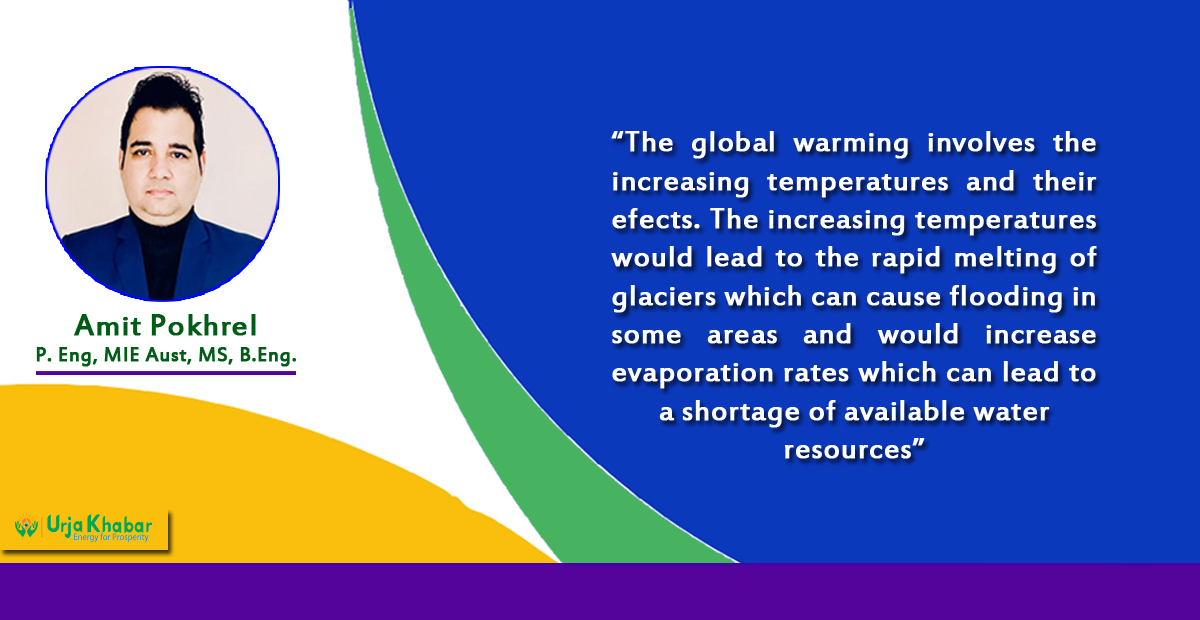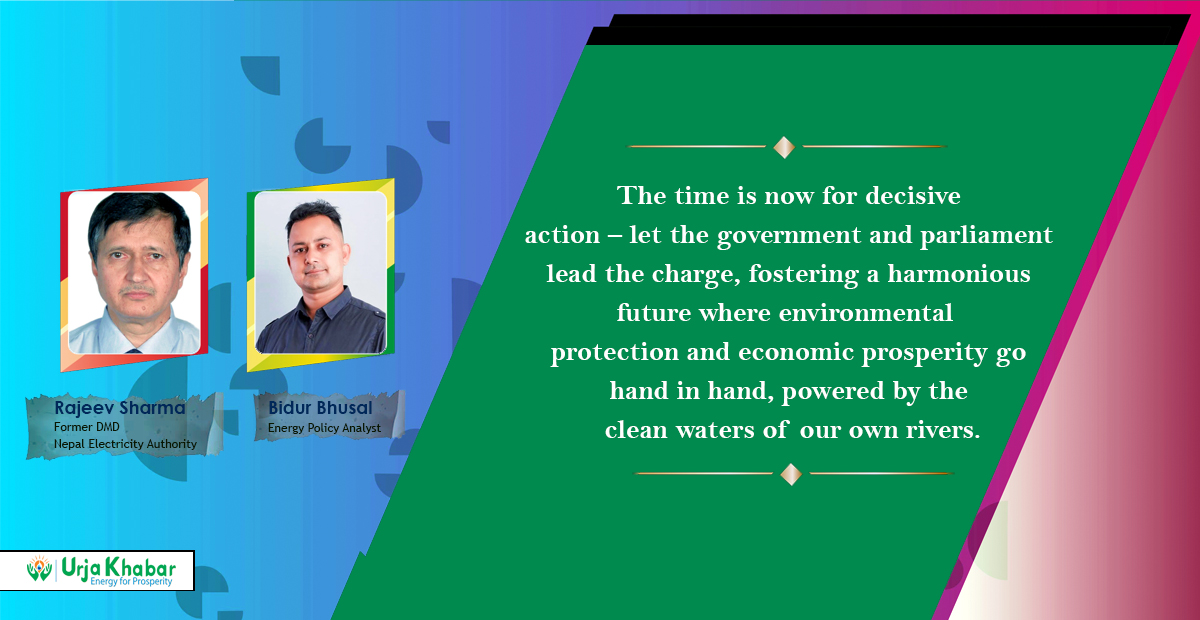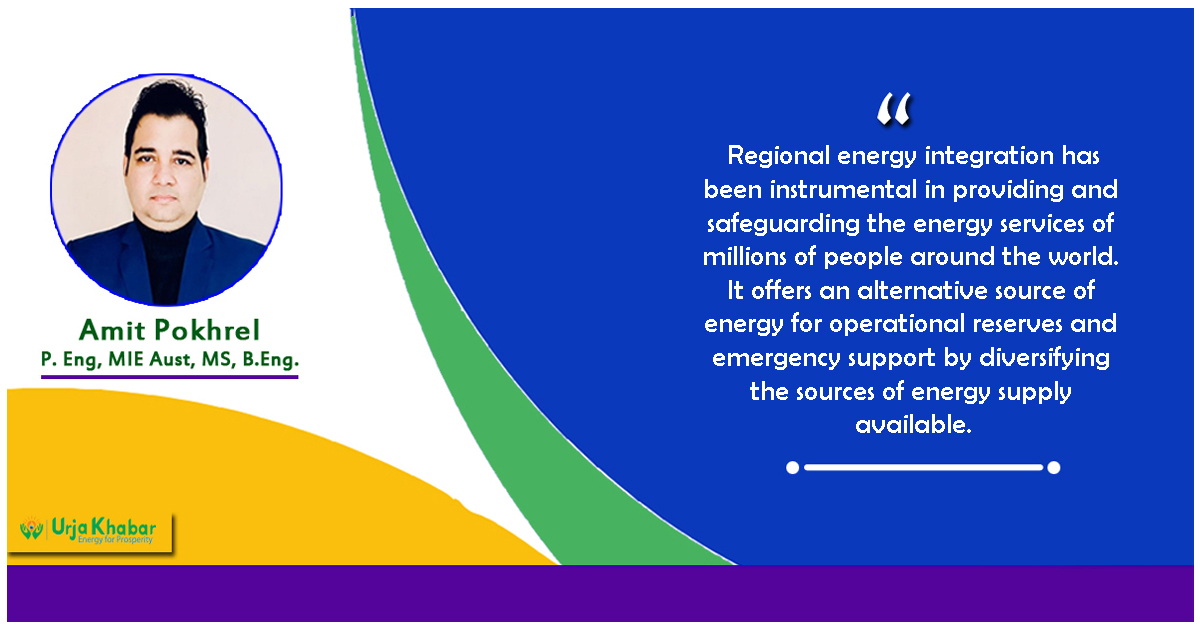Energy Update
Climate Change Impact in Nepal’s River from Hydrological Response Perspective

Introduction
Climate change is a change in the state of climate identified by a change in temperature and precipitation that affects the hydrology of basins. Climate change affects the hydrologic cycle by altering the hydrological responses including streamflow, surface runoff, base flow, and evapotranspiration. Only a few studies have addressed the impacts of climate change on watershed hydrology.
Water is a mobile resource it falls from the clouds, seeps into the soil, flows through aquifers, runs along stream courses, and eventually backs to the cloud. Climate change impact studies associated with global warming as a result of an increase in greenhouse gases (GHG) have been given ample attention worldwide in recent decades. However, hydrological impact studies ought to receive more attention as there are still grey areas. Therefore, an attempt has been made in this study to assess the impact of climate change on hydrologic responses. Hence hydrology of the catchment incorporating climate change is assessed to cope up with the impact.

Climate change impacts are potential concerns nowadays and the climate system is varying faster than the natural patterns. Climate change impacts the environmental, ecological, and hydrological courses at global, regional, and local levels. These impacts can interrupt the structure and effectiveness of the ecosystem, increase natural disturbances, and change the distribution of water resources and vegetation patterns. Climate change has a substantial impact on the hydrological response that has then affected the available water resources. The variation in precipitation, droughts, runoff, and evapotranspiration is because of climate change. The Intergovernmental Panel on Climate Change (IPCC) has studied those watersheds are badly affected because of the changing patterns of temperature and precipitation. In a watershed, the streamflow fluctuates non-linearly with changes in precipitation.
Both land use and land cover and climate change affect the spatial and temporal variability of the watershed hydrology through modifying streamflow, surface runoff, base-flow, and evapotranspiration. According to the Intergovernmental Panel on Climate Change report (IPCC, 2014), global average temperatures and frequency of heavy precipitation events are expected to increase in the mid-21st century. These changes will affect the hydrologic cycle through enhanced evaporation, peak flow, and flooding. Furthermore, land-use change seriously affects water resources mainly through partitioning of the rainfall amount into interception, evapotranspiration, infiltration, and soil moisture storage, thereby affecting the availability of watershed hydrology (Mishra et al., 2010; Mango et al., 2011).

Human activities especially agricultural land expansion at the expense of forest cover have been the primary reason for the land-use change (Mottet et al., 2006). The impact assessment study showed that interactions between land use and climate could create serious challenges for water quantity and quality. Therefore, understanding the combined effects of land use and climate change can be a basis for improved water resources management.
Nepal and Climate Change Impacts
According to the World Bank (2019), the climate risk country profile for Nepal indicates warming in Nepal is projected to be higher than the global average. By the 2080s, Nepal is projected to warm by 1.2°C–4.2°C, under the highest emission scenario, RCP8.5, as compared to the baseline period 1986–2005. The range in possible temperature rises highlights the significantly lower rates of warming expected on lower 21st-century emissions pathways. Climate change is already having significant impacts on the environment in Nepal, species’ ranges are shifting to higher altitudes, glaciers are melting, and the frequency of precipitation extremes is increasing.
Water and forests are Nepal’s most abundant natural resources, with freshwater (derived from glaciers, snowmelt, and rainfall) accounting for an estimated 2.27% of the total world supply. This water feeds the country’s major rivers: Koshi, Gandaki, and Karnali. Together, these river systems supply fresh water to a large portion of the 500 million people who live in the Ganges River basin. Nepal’s varied topography and social vulnerability make the country particularly susceptible to geological and climate-related disasters.
In contrast, weakness ineffective response mechanisms and strategies for dealing with natural hazards have historically exacerbated this vulnerability. An increase in soil erosion, landslides, flash floods, and droughts has been reported in recent years across the country, with increased intensity and impact on the lives and livelihoods of the Nepalese. Nepal is highly vulnerable to climate change impacts and recent studies by the Asian Development Bank suggested Nepal faces losing 2.2% of annual GDP due to climate change by 2050. Nepal ratified the Paris Climate Agreement and its Second Nationally Determined Communication (NDC) in 2020. Nepal’s Second National Communication to the UNFCCC (2014) (NC2) identifies the country’s energy, agriculture, water resources, forestry and biodiversity, and health sectors as the most at risk of climate change.
Nepal’s climate varies considerably both seasonally and according to altitude. Nepal can be divided into different climate zones according to altitude, ranging from the Terai region in the south at less than 500 m above sea level to the High Himalayan region in the north at over 5,000 m. Average temperatures decline from a peak of over 24°C in the south down to sub-zero temperatures in Nepal’s highest mountains. Precipitation is spatially variable with some central and northerly pockets of the country receiving more than 3,000 millimeters (mm), the central and southern plains typically receiving 1,500–2,000 mm, and some high-altitude areas in the north receiving less than 1,000 mm.
Climate Change and Hydrology
As per the Water and Energy Commission Secretariat (WECS, 2003), Nepal is rich in water resources. There are about 6000 rivers in Nepal having a drainage area of 191000 sq. km, 74% of which lies in Nepal alone. There are 33 rivers having drainage areas exceeding 1000 sq. km. Drainage density expressing the closeness of spacing of channels is about 0.3 km/sq. km. the surface water available in the country is estimated to be about 225 billion m³ per annum, equivalent to an average flow of 7.125 m³/s. The cumulative lengths of rivers are 45,000 km. There are 1000 rivers longer than 10 km and about 24 of them are more than 100 km. These rivers are reliable sources of water and also provide potential opportunities for hydropower generation and irrigation downstream.
Although water resources are highly vulnerable to climate change, several studies have investigated the impact of climate change on the hydrological responses. Very few studies of climate change's impact on water resources have been conducted in Nepal. The expansion of cropland and deforestation accompanied by climate change may impose an unprecedented impact on watershed hydrology, whereas afforestation and water harvesting structures may modify the negative impact of climate change. Nepal’s river tributaries where small- and large-scale hydropower projects are planned to improve the livelihood of the community. However, there is inadequate information about land management practices in modifying the impact of climate change on water resources at the watershed level.
It would be imprecise to include all these aspects of the status of Nepal's river in a single status, and it would be presumptuous to apply such a theory which may not apply to all parts of Nepal. However, to cover up the catchment area of the Nepal River, it was sorted to sum up in such a way that would reflect Nepal’s river presence and help us to find the effect of climate change in those rivers which would be a residual impact in the future. However, to address the impact of climate change on Nepal’s river from a hydrological aspect, the catchment area shall be well defined.
In recent decades, the significant impact of climate change on water resources and hydrology has attained great attention through several studies in many regions all around the world. Therefore, a hydrological response analysis is very important to evaluate the sensitivity of a watershed to climate change circumstances and to develop better water management structures and climate change adaption tactics. Researchers investigated hydrological response to climate change in many river basins in Asia and Europe and their results indicate that when precipitation keeps unchanging, temperature increase would increase average annual evaporation and potential evaporation and decrease water yield.
Climate Change Forecasting Technological Tools
Many research studies on precipitation changes were done at country or regional levels because of the climate changes at the regional level and the analysis of long-term simulated precipitation data by climate models. Water resources will be improved in some regions of the world and on the other hand, will be degraded in some regions of the world too. The ecological, environmental, and hydrological response is more sensitive to anthropogenic climate change than natural climate variability. The climate change variations indicated the decreased water balance components. Ahmad et al. investigated water resources management about environmental changes in the Himalayan watershed region. The understanding of human-climate-environment interactions is important for the assessment of ecosystems’ vulnerability to future climate change impacts.
Forecasting the potential hydrological response to future climate change is an effective way of assessing the adverse effects of future climate change on water resources. Global climate change is considered one of the major threats to human survival and development. These changes will be expected to reinforce the hydrological cycle by changing the precipitation regime, altering the streamflow, increasing evapotranspiration, potentially having significant implications for freshwater resources, and consequently, threatening the sustainability of the natural environment as well as people’s well-being. Projection of future climate impact on the behavior of hydrological processes is therefore becoming increasingly essential for assessing the availability of surface water resources and formulating future climate change adaptation strategies. Regional scale studies covering the individual watershed are more helpful for understanding local hydrological processes compared to those on continental or global scales. Scientific approaches for improving the preciseness of existing methods for water availability, especially at local scales, are pertinent tools in core decision-making. Hydrological processes have been the most important aspect related to studying the impact of climate change on hydrology for global hydrological communities.
The monitoring and warning systems can be improved as main efforts for adaptation to climate extremes and reduction of disaster impacts. Better management practices are needed for adaptation to and mitigation of climate impacts on watersheds such as water runoff variations. Climate change is profoundly impacting the hydrological response in the watershed. The global warming involves the increasing temperatures and their effects. The increasing temperatures would lead to the rapid melting of glaciers which can cause flooding in some areas and would increase evaporation rates which can lead to a shortage of available water resources. The increasing temperatures and decreasing rainfall trends would lead to a shortage of water resources in this region. Climate change would also increase the frequency and intensity of extreme climatic events. Extreme climatic events inflict significant damage and losses to humans, ecosystems, and the environment. Based on this study, for future research, to envisage the hydrological changeability because of the land use, as there are numerous inconsistencies, accompanying future climate change systems.
Climate change has significantly influenced the hydrological cycle, and hydrological responses to climate change have many implications for water resource management and adaptation. Considerable evidence has shown that climate change has resulted in longer dry seasons, shorter rainy seasons, more floods and droughts in tropic and subtropic zones, and reduced snow cover and its duration as well as snowfall/rainfall ratio in high-latitude regions and alpine mountains. The hydrological response to climate change can be investigated through in-situ and remote sensing observation of hydrological components, and through the hydrological model of the response of different components of the hydrological cycle, which includes precipitation, soil moisture, evapotranspiration, base flow, precipitation form, groundwater recharge, and runoff. This collective information will report on the progress and findings of hydrological responses to climate change.
Conclusion
Weather, climate variability, and climate change are important considerations in water resources-related investigations, such as urban water policy, environmental quality assessments, distribution and productivity of terrestrial vegetation, land resources management, ecology, and sediment yield.
In this context, concern has grown in recent years over the issue of global climate change in which increased greenhouse gas emissions led to changes in the distribution of water resources over many regions. The global and regional hydrological cycles have been greatly influenced by climate change in the past century and the availability and distribution of freshwater resources will be greatly affected by climate change thus having the potential to impose additional water stress. It has also been recognized that climate change is foreseen to increase water stress in some parts of the world and increase flood risk in others, along with a decline in water quality. This will affect the terrestrial water cycle and human livelihoods in the future.
This emphasizes the importance of assessing the motivation for climate change considerations in the adaptive management of water resources. Modeling the hydrologic impacts of climate change on river basins involves two issues: climate change and hydrologic systems response. Climate change will lead to a significant alteration in the temporal and spatial pattern variation in the regional hydrological cycle, and the subsequent lack of water, environmental deterioration, floods and droughts, etc. And it is especially remarkable in semi-humid and semi-arid regions. During the past few years, a progressive worldwide change in climatic conditions has been observed that has consequently brought increases in the frequency and severity of phenomena like floods and droughts. Thus, it is necessary to have tools for making informed decisions not just for the community to react, but also for hydropower projects in the river area that need to think about the long-term sustainability of their operations.
(The Author of this article works as a Senior Contract management and Project Expert in the Energy Business of Golyan Group and is a Professional member of Engineer’s Australia)
Reference
1. 15720-WB_Nepal Country Profile-WEB.pdf (worldbank.org)
2. Impacts of Climate and Land Use Change on Hydrological Response in Gumara Watershed, Ethiopia - ScienceDirect
3. HESS - Hydrological response to climate change and human activities in the Three-River Source Region (copernicus.org)
4. Water | Special Issue: Hydrological Response to Climate Change (mdpi.com)
5. | Journal of Water and Climate Change | IWA Publishing (iwaponline.com)
6. Hydrological response to changing climate conditions: Spatial streamflow variability in the boreal region (diva-portal.org)
7. P020141121533298011003.pdf (cas.cn)
8. MAJOR RIVER BASINS OF NEPAL - Blogger Nepal
9. Modeling the hydrological response to climate change: experiences from two south-central Chilean watersheds (scielo.org.mx)
10. (PDF) Hydrological Response to Climate Change Impacts in the Karkheh River Basin (researchgate.net)
11. Hydrological Response to Climate Change - Stockholm Resilience Centre
12. Introduction to Hydrological Response (academic-accelerator.com)
Conversation
- Info. Dept. Reg. No. : 254/073/74
- Telephone : +977-1-5321303
- Email : [email protected]














